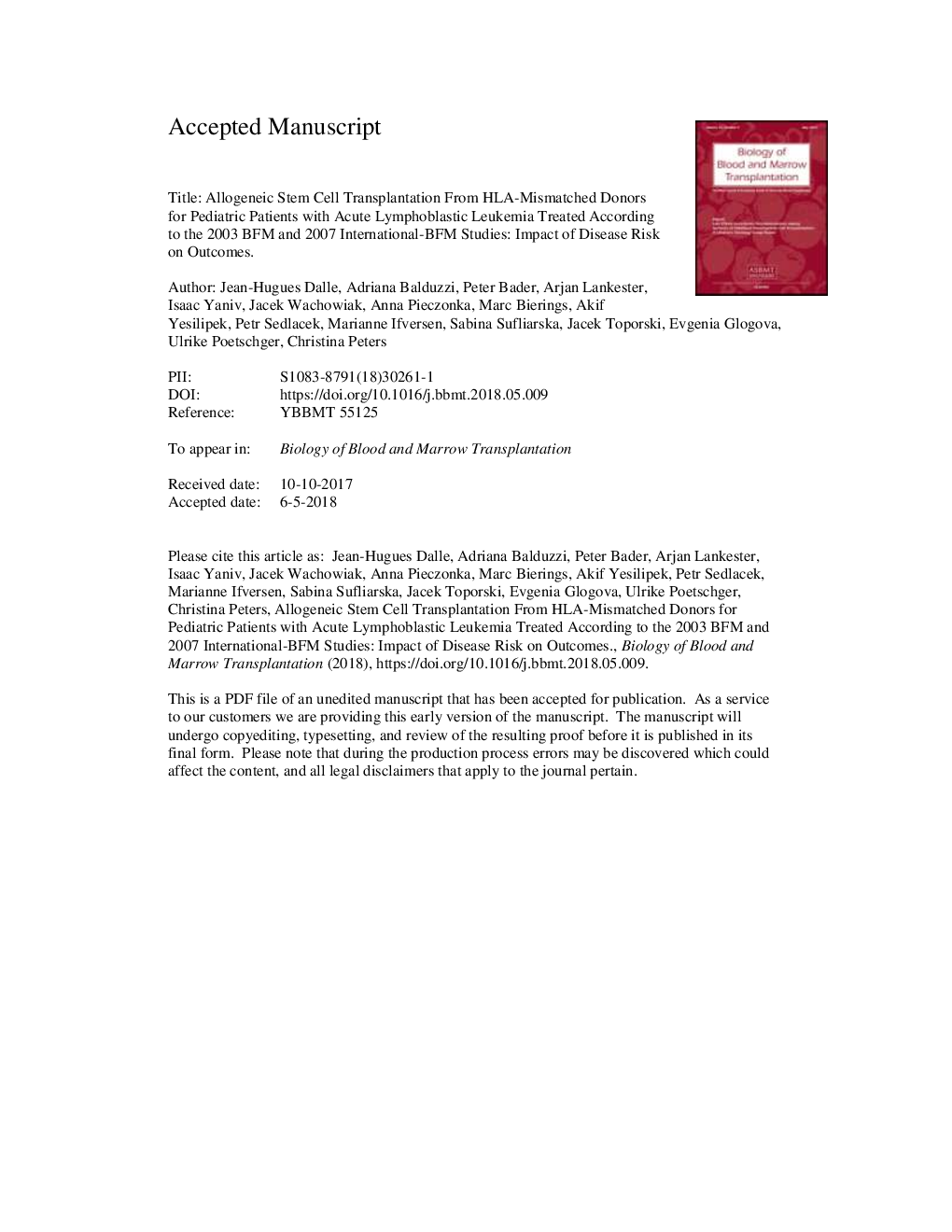| کد مقاله | کد نشریه | سال انتشار | مقاله انگلیسی | نسخه تمام متن |
|---|---|---|---|---|
| 10157456 | 1666466 | 2018 | 26 صفحه PDF | دانلود رایگان |
عنوان انگلیسی مقاله ISI
Allogeneic Stem Cell Transplantation from HLA-Mismatched Donors for Pediatric Patients with Acute Lymphoblastic Leukemia Treated According to the 2003 BFM and 2007 International BFM Studies: Impact of Disease Risk on Outcomes
دانلود مقاله + سفارش ترجمه
دانلود مقاله ISI انگلیسی
رایگان برای ایرانیان
موضوعات مرتبط
علوم زیستی و بیوفناوری
بیوشیمی، ژنتیک و زیست شناسی مولکولی
تحقیقات سرطان
پیش نمایش صفحه اول مقاله

چکیده انگلیسی
Allogeneic hematopoietic stem cell transplantation (HSCT) is beneficial for pediatric patients with relapsed or (very) high-risk acute lymphoblastic leukemia (ALL) in remission. A total of 1115 consecutive patients were included in the ALL SCT 2003 BFM study and the ALL SCT 2007 I-BFM study and were stratified according to relapse risk (standard versus high versus very high risk of relapse) and donor type (matched sibling versus matched donor versus mismatched donor). A total of 148 patients (60% boys; median age, 8.7 years; B cell precursor ALL, 75%) were transplanted from mismatched donors, which was defined as either less than 9/10 HLA-compatible donors or less than 5/6 unrelated cord blood after myeloablative conditioning regimen (total body irradiation based, 67%) for high relapse risk (HRR; nâ=â42) or very HRR (VHRR) disease (nâ=â106). The stem cell source was either bone marrow (nâ=â31), unmanipulated peripheral stem cells (nâ=â28), T cell ex vivo depleted peripheral stem cells (nâ=â59), or cord blood (nâ=â25). The median follow-up was 5.1 years. The 4-year rates of overall survival (OS) and event-free survival were 56%â±â4% and 52%â±â4%, respectively, for the entire cohort. Patients transplanted from mismatched donors for HRR disease obtained remarkable 4-year OS and event-free survival values of 82%â±â6% and 80%â±â6%, respectively, whereas VHRR patients obtained values of 45%â±â5% and 42%â±â5% (Pâ<â.001), respectively. The cumulative incidence of relapse was 29%â±â4% and that of nonrelapse mortality 19%â±â3%. The cumulative incidence of limited and extensive chronic graft-versus-host disease was 13%â±â3% and 15%â±â4%, respectively, among the 120 patients living beyond day 100. Multivariate analysis showed that OS was lower for transplanted VHRR patients (Pâ=â.002; hazard ratio [HR], 3.62; 95% confidence interval [CI], 1.60 to 8.20) and for patients beyond second complete remission (CR2) versus first complete remission (Pâ<â.001; HR, 3.68; 95% CI, 1.79 to 7.56); relapse occurred more frequently in patients with VHRR disease (Pâ=â.026; HR, 3.30; 95% CI, 1.16 to 9.60) and for those beyond CR2 (Pâ=â.005; HR, 4.16; 95% CI, 1.52 to 10.59). Nonrelapse mortality was not significantly higher for cytomegalovirus-positive recipients receiving cytomegalovirus-negative grafts (Pâ=â.12; HR, 1.96; 95% CI, .84 to 4.58). HSCT with a mismatched donor is feasible in pediatric ALL patients but leads to inferior results compared with HSCT with better matched donors, at least for patients transplanted for VHRR disease. The results are strongly affected by disease status. The main cause of treatment failure is still relapse, highlighting the urgent need for interventional strategies after HSCT for patients with residual leukemia before and/or after transplantation
ناشر
Database: Elsevier - ScienceDirect (ساینس دایرکت)
Journal: Biology of Blood and Marrow Transplantation - Volume 24, Issue 9, September 2018, Pages 1848-1855
Journal: Biology of Blood and Marrow Transplantation - Volume 24, Issue 9, September 2018, Pages 1848-1855
نویسندگان
Jean-Hugues Dalle, Adriana Balduzzi, Peter Bader, Arjan Lankester, Isaac Yaniv, Jacek Wachowiak, Anna Pieczonka, Marc Bierings, Akif Yesilipek, Petr Sedlaçek, Marianne Ifversen, Sabina Sufliarska, Jacek Toporski, Evgenia Glogova, Ulrike Poetschger,